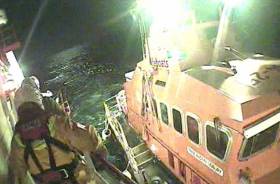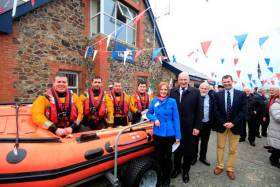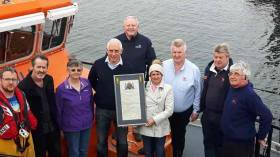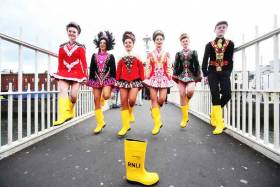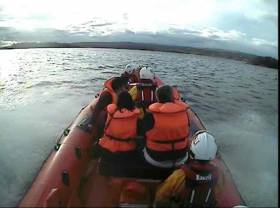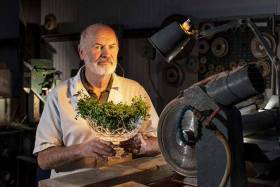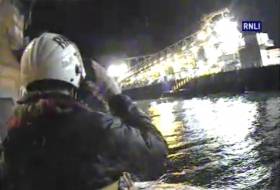Displaying items by tag: Lifeboat
Ballycotton RNLI launched in the early hours of this morning (Wednesday 10 May) to assist in the medical evacuation of a fisherman 20 miles south of Ballycotton Lighthouse.
The volunteer lifeboat crew was requested to launch their all-weather lifeboat by the Irish Coast Guard at 12.33am.
The lifeboat under Coxswain Eolan Walsh and with six crew members onboard launched to meet the fishing vessel which had five crew members onboard and was making its way to Ballycotton.
The Irish Coast Guard helicopter Rescue 117 from Waterford was also tasked.
Weather conditions at the time were described as good with a easterly Force 1-2 wind blowing.
Arriving at 1.20am, two lifeboat crew members were immediately put on board the casualty’s vessel where they proceeded to assess the man and administer casualty care.
The man was then transferred onto the lifeboat and brought back to Ballycotton where he was transferred into care of a waiting ambulance crew on the pier.
Speaking following the call out, Ballycotton RNLI Coxswain Eolan Walsh said: ‘We were glad the fishermen, all of whom were wearing lifejackets, were able to raise the alarm when one of their crew members began to feel unwell and required medical assistance. We would like to wish the man a speedy recovery following his ordeal early this morning.
‘As we approach the summer months, we would remind anyone taking to the sea to always carry a means of calling for help or signalling should you need assistance. It is also important to let someone on the shore know when you set sail and when you are due back.’
Wicklow D Class Lifeboat Named After Late Couple’s Dream to Fund a Lifeboat is Fulfilled
At a special ceremony held yesterday (Saturday 6 May), Wicklow RNLI officially named its new D class lifeboat, Dennis-Audrey.
David Delamer, chair of the RNLI Council in Ireland, accepted the lifeboat on behalf of the RNLI before handing her over into the care of Wicklow Lifeboat Station.
The funding for the new lifeboat came from Gladys Audrey Deakin, known as Audrey, who lived in Coventry, and left her residuary estate to the RNLI.
Audrey and her late husband Dennis loved holidays by the sea and were impressed by the work of the charity’s volunteers. It was their dream that their bequest be used to fund a lifeboat and that it would be named after them.
 Wicklow RNLI performs a simulated exercise on the new lifeboat for well-wishers at the end of the naming ceremony and service of dedication for the D class Dennis-Audrey.
Wicklow RNLI performs a simulated exercise on the new lifeboat for well-wishers at the end of the naming ceremony and service of dedication for the D class Dennis-Audrey.
The couple were represented at the ceremony by Audrey’s solicitor Michelle Gavin who handed the lifeboat to the RNLI.
In his address, Mr Delamer said that one may be forgiven for thinking that we knew little about Audrey as Michelle’s relationship with her began posthumously as executor of her will.
‘But,’ he continued, ‘we know a great deal about her through one simple action; she has provided us with this life-saving vessel. That vessel has found a home here in Wicklow and will go on to save many lives and bring countless loved ones home. That one fact says a great deal indeed about Audrey and we will remember her for her generosity and her humanitarianism for many years to come.’
Phylis Whyte, former chair of the Wicklow RNLI fundraising branch had the honour of officially naming the lifeboat during the ceremony.
Des Davitt, Wicklow RNLI Lifeboat Operations Manager said the naming ceremony and service of dedication was a wonderful occasion in the history of the lifeboat station, and paid tribute to the generosity of Dennis and Audrey Deakin.
Speaking following the ceremony he said: ‘This new craft which will be housed and work alongside our all-weather lifeboat, gives our volunteer crew the power, equipment and rescue platform they need to keep those who use the sea safe.
 Wicklow RNLI female crew members Carol Flahive, Amy O’Neill, Brid Seoighe, Lisa O’Leary and Deputy Launching Authority Mary Aldridge.
Wicklow RNLI female crew members Carol Flahive, Amy O’Neill, Brid Seoighe, Lisa O’Leary and Deputy Launching Authority Mary Aldridge.
‘Every rescue is powered by our generous supporters, people like Dennis and Audrey. Their kind and selfless gift will help ensure we in Wicklow are ready for the next call, wherever and whenever it comes. For that, the RNLI and everyone at Wicklow lifeboat station will be forever grateful to them.
Mr Davitt paid tribute to the volunteers at Wicklow RNLI saying it was they who would give the new boat life: ‘Their commitment and ongoing attendance for training means that they are highly proficient in the operation of both our lifeboats. Further testament of the dedication of the crew is their knowledge that they may risk their own lives in the service of others. There is nothing greater that a person could offer and they deserve nothing less than the best lifeboat, equipment and training that money can buy.’
He thanked the local fundraising branch too, for their untiring work and praised the generosity of the people of Wicklow and further afield for helping to raise funds to enable the station to continue to save lives at sea.
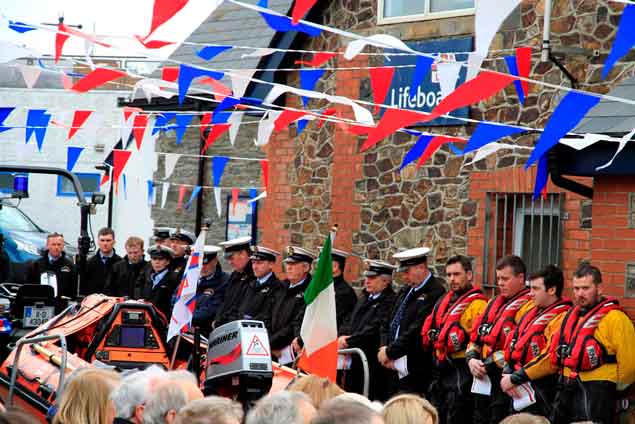 Wicklow RNLI lifeboat crew pictured alongside their new D class lifeboat Dennis-Audrey during the naming ceremony and service of dedication at Wicklow lifeboat station.
Wicklow RNLI lifeboat crew pictured alongside their new D class lifeboat Dennis-Audrey during the naming ceremony and service of dedication at Wicklow lifeboat station.
He added that while this was a time for celebration it was also a time to acknowledge the risks taken by all emergency service personnel in the service of others. A minutes silence was observed at the start of the ceremony in remembrance of five brave members of the Irish Coast Guard who lost their lives in the past year, Catriona Lucas, Dara Fitzpatrick, Mark Duffy, Ciaran Smith and Paul Ormsby.
Last year, Wicklow RNLI which also has an all-weather lifeboat launched 37 times and rescued 38 people. The all-weather Tyne class lifeboat Annie Blaker launched 21 times bringing 28 people to safety while the inshore lifeboat launched 16 times bringing 10 people to safety.
The new inshore lifeboat is replacing the Sheringham Shantymen, which was on service for 10 years at Wicklow RNLI. The lifeboat which was named after the Sheringham Shantymen was funded by money raised at their concerts. During its time in Wicklow, the lifeboat rescued 96 people, seven dogs and a farmer’s sheep.
First introduced into the RNLI fleet in 1963, the design of the inflatable D class lifeboat continues to evolve to meet changes in demand and technology.
It is the workhorse of the RNLI’s fleet and is ideal for working close inshore, near rocks or in shallow water in moderate conditions. It can be righted by the crew if it capsizes and is also part of the RNLI Flood Rescue Teams fleet of boats.
A highly manoeuvrable lifeboat, the D class can operate closer to shore than Wicklow’s all-weather lifeboat and comes into her own for searches and rescues in the surf, shallow water and confined locations - often close to cliffs, among rocks and even inside caves.
A lifeboat station was established in Wicklow in 1857. The first lifeboat was a 30ft rowing boat.
In 1911 the boathouse was adapted and the station’s first motor lifeboat, the first for Ireland, arrived.
In 1989, the boathouse was adapted once again and the slipway extended for the station's new Tyne class lifeboat. The adaptation to the boathouse included improved crew facilities and additional extensions for the refurbished winch and a souvenir sales outlet. The slipway was extended by 24 metres.
A D class lifeboat first went on service in Wicklow in 1995 with a new boathouse extension for housing the lifeboat completed in 1997.
A crowd of well-wishers turned up to see the lifeboat officially named with a bottle of champagne poured over the side of the boat by Phylis Whyte. Following the ceremony the crowd gathered around the harbour wall to see the lifeboat launch and watch as helm Alan Goucher, Connie O’Gara, Dean Mulvihill and Paul Sillery performed a simulated exercise.
Among the guests officiating at the ceremony were Judge Gerard Haughton, chair of the Lifeboat Management Group who welcomed guests and opened proceedings; Michelle Gavin, representative of the donor, who handed the lifeboat over to the RNLI, David Delamer, chair of the RNLI Council for Ireland, who accepted the lifeboat on behalf of the RNLI and handed her into the care of the lifeboat station and Des Davitt, Wicklow RNLI Lifeboat Operations Manager, who accepted the lifeboat on behalf of the station. A vote of thanks at the end was read out by Jill Clancy-Harold, Wicklow RNLI fundraising chair.
Father Donal Roche, parish priest, and Reverends Ken Ru and Jack Kinkead, led the Service of Dedication.
Sean Olohan and the Wicklow Swim for Life choir led the congregation in song
Only 21% of Lifejackets 'Free of Faults': Dun Laoghaire RNLI Issue Lifejacket Safety Warning At Ireland's Biggest Boating Centre
Dun Laoghaire RNLI is making a timely warning this Bank Holiday weekend to all lifejacket owners to ensure the appropriate safety checks are carried out by a competent agent ahead of the main boating season.
The safety appeal comes following the results from a free lifejacket advice clinic held in Dun Laoghaire by the RNLI’s community safety team last weekend.
Of the 131 lifejackets checked, only 21% were found to be completely fault free.
The lifejackets were brought to the free clinic by a variety of boat users and were checked by experienced RNLI volunteers. While the RNLI offers sea safety advice it does not offer a pass or fail assessment on lifejacket servicing.
Just over half the units tested had the recommended crotch straps fitted that are considered vital to ensure that a lifejacket inflates correctly on the wearer and remains in place, keeping the wearer’s head above the water and helping to prevent fatigue.
There were numerous examples of life-threatening problems detected during the checks. Ninety of the units had out of date firing mechanisms and 23 had corroded gas bottles that risk incorrect inflation in an emergency.
Speaking following the clinic, Stephen Wynne, Dun Laoghaire RNLI Lifeboat Operations Manager said: ‘Although we are very pleased that more than 100 lifejackets were checked, the fault rate is extremely worrying when you think that anyone taking to the water needs and relies on a lifejacket should they get into trouble. As the main boating season gets underway, we are appealing to everyone thinking of going on the water to ensure that they not only have a lifejacket but that every user has their lifejacket checked by a competent agent. This is so important and could save a life.’
Other problems identified at the clinic included lifejackets that had already been fired (3), missing gas cylinders (3), missing firing mechanisms (3), bladder abrasion (3), holed bladder (3) and one unit that was so old it didn't inflate at all.
‘It is essential that the correct type of lifejacket is used depending on the planned activity’, added Peter Richardson, Dun Laoghaire RNLI Community Safety Officer. ‘Specialist activities such as offshore racing or cruising need lifejackets fitted with a spray hood, light and space for a personal locator beacon (PLB). People who do not fit a crotch strap to their lifejacket or who do not use it when fitted is risking their lives should they end up in the water’.
RNLI Award for Gallantry Returned to Aran Islands
The grandnephew of an RNLI bowman who was awarded the charity’s bronze medal for gallantry for his part in the daring rescue of 12 people from a Greek freighter back in 1938, has made a visit from the UK to Galway this week to present the Aran Islands lifeboat crew with a precious gift.
John Harwood’s grand uncle Patrick Flaherty was the bowman of the Galway Bay (now Aran Islands RNLI) motor lifeboat which was called out on the night of the 16-17 August 1938. He was subsequently awarded in recognition of his meritorious conduct when together with four other men he courageously manned a small boat and rescued the crew of 12 of the steam trawler ‘Nogi’ which had run aground near Straw Island Lighthouse, Aran Isles, during a strong westerly-south westerly wind with a very heavy sea.
An online article describes how a boat from the Hatano with four men went to her rescue and at once got into difficulties. The lifeboat went first to the small boat, the rowlock of which caught in the fender of the lifeboat, and there was danger of a serious accident. The motor mechanic jumped aboard the boat and smashed the rowlock with a hatchet. The four men were rescued and their boat towed away. It was impossible for the lifeboat to get alongside the Nogi but five of her crew manned the small boat; it was lowered by a rope down to the Nogi and in two journeys rescued the 11 men on board her. A member of the Nogi's crew had been swept away in the trawler's boat when she struck. His boots were found on an island, but it was only after eight hours' search that the man was found dazed and exhausted. The whole rescue had taken over 14 hours.
When John’s uncle Paddy who lived in the north west of England and worked most of his life as a miner, died in 1998, he left John his father’s citation for the bronze medal which is written on vellum.
 Historic Vellum returned to the Aran Islands
Historic Vellum returned to the Aran Islands
‘This always had pride of place in my uncle’s house,’ John explained, ‘and as a child he often told me the story about how his father and I think his older brother took part in the rescue. He also regaled me with tales of his life on Aran, particularly his connection with the sea. This influenced me in later life to love the sea and along with my wife I have had a 30 year passion for the sea as a diver and yachtsman.’
John’s visit to Galway yesterday evening (Wednesday 19 April) follows his decision to return the citation to Aran Islands RNLI.
‘As time marches on, I realise that there will be no one to appreciate the award when my wife and I are no longer here, so I think it is high time that the award is returned to the Aran Islands where it belongs. I believe that my uncle may still have family on the Islands. I think the award should lie with them or with the lifeboat station.’
John and his wife Mary met members of both Aran Islands and Galway RNLI in Rosaveal yesterday evening before John presented the citation on vellum to Aran Islands RNLI Coxswain John O’Donnell.
‘We are extremely touched by John and Mary’s generous gesture to place what is their precious heirloom into the care of Aran Islands lifeboat station. RNLI medals for gallantry are rare and are presented for acts of bravery and this was certainly the case on the night the lifeboat carried out the rescue of the Nogi in 1938. We are very grateful to receive this award from John and Mary and can assure them it will take pride of place in his granduncle Patrick Flaherty’s lifeboat station.’
An RNLI lifejacket worth £458 has been stolen from Portaferry lifeboat station in County Down.
The lifejacket, a vital part of a volunteer crew member’s kit, is thought to have been stolen sometime between 2 March and 10 April.
The unique lifejacket is designed specifically for search and rescue and is fitted with a water activated emergency light and integral flare pockets for day and night distress flares.
Brian Bailie, Portaferry RNLI Lifeboat Operations Manager said: ‘The lifejacket is an expensive and essential piece of our volunteers’ crew kit. It was innovatively designed with search and rescue in mind which means it provides increased safety, efficiency and effectiveness for crew when they respond to a call out. On top of its features, it also holds zipped pockets for items including casualty care kit, torches and gloves and has a spray hood to protect against sea spray.
‘It will cost the RNLI almost £500 to replace this lifejacket which is a significant loss to the charity which relies on the public’s generosity to save lives at sea.’
Anyone with any information is asked to get in touch with the PSNI by calling 101 and quoting CC2017041700737.
The 2017 World Irish Dancing Championships come to a close in Dublin today but not before a group of the budding dance stars swapped their pumps and hard shoes for the RNLI’s yellow wellies to show their support for Mayday, the charity’s annual national fundraising campaign which is calling out for people to ‘Do your bit, fund our kit’.
The talented troupe of Irish dancers who were competing in the 47th World Irish Dancing Championships organised by An Coimisiún le Rincí Gaelacha, showed off their signature moves in bright yellow wellies in Dublin’s city centre to encourage the public to support Mayday, which is raising funds for crucial RNLI kit for the charity’s brave volunteer lifeboat crews.
Worn by generations of crews to grip the deck in slippery conditions, the iconic yellow wellies keep crew members safe and steady on stormy seas. Just like Irish dancing shoes, RNLI-issue sea boots have reinforced toecaps to protect the crews’ feet.
Doireann Ní Ryan from the Ryan School of Irish Dancing in Tipperary said: ‘Swapping my Irish dancing shoes for yellow wellies has been a humbling experience. I couldn’t dance without my pumps or hard shoes and the RNLI’s volunteers couldn’t save lives at sea without their yellow wellies and the rest of their lifesaving kit. So, I’d encourage everyone to visit RNLI.org/Mayday to see how they can support the RNLI’s Mayday campaign.’
Mayday distress calls can come in any time, day or night, 365 days a year, with volunteer crew members from 46 lifeboat stations in Ireland on standby to drop everything in an instant to save lives at sea.
Pauline McGann, RNLI Community Fundraising Manager said: ‘Our crews rely on lifesaving kit, like their yellow wellies, lifejackets and helmets, when they go out in all weathers to save lives at sea. From sponsored bike rides and welly walks, to running a bake sale, there are all sorts of ways to raise money for the RNLI this Mayday. Visit RNLI.org/Mayday to download a fundraising pack and see how you can do your bit to fund our kit.’
Money raised through Mayday fundraising events will help kit out RNLI lifeboat crews so they’re ready to face the harshest conditions at sea, with it costing €2,168 to provide an all-weather lifeboat crew member with all of the vital kit they need during a rescue.
Mayday fundraising events are taking place right across Ireland, many with a yellow welly theme.
In Dublin, a D class lifeboat will be on display in Grand Canal Square as yellow welly pin badges will be sold on Thursday and Friday 27 and 28 April from 10am to 4pm. An Atlantic 85 class lifeboat will be on display on Patrick Street in Cork city where badges will be on sale on the 28 and 29 April. Meanwhile, across the west of Ireland, badges will be on sale at various shopping centres and supermarkets over two weekends from the 29-30 April and 5-6 May. Mayday badges will also be on sale in Aldi stores on Mayday, Monday 1 May.
On Saturday afternoon, Valentia Coast Guard requested Lough Derg RNLI Lifeboat to launch to assist 10 people after their 40ft cruiser ran aground by the Scilly Islands on Lough Derg. Valentia Coast Guard informed the lifeboat that the Killaloe Coast Guard RIB had also launched to assist.
At 5.45pm, the lifeboat launched with helm Eleanor Hooker, Ger Egan, and Keith Brennan on board. Winds was south-westerly, Force 4, gusting 5. Visibility was good. Valentia Coast Guard informed the lifeboat that the Killaloe Coast Guard RIB had also launched to assist.
The lifeboat arrived on scene at 6pm, the casualty vessel was aground north of the Scilly Islands. The Killaloe Coast Guard commenced an anchor and veering down to the casualty vessel. All ten people were unharmed and wearing their lifejackets. As the vessel was high on a rocky shelf, it was decided to transfer all casualties to Mountshannon Harbour, five on board Lough Derg RNLI lifeboat and five on board the Killaloe Coast Guard RIB, and where the land mobile Coast Guard unit was waiting to receive the casualties.
Both the lifeboat and the Coast Guard RIB returned to the casualty vessel. Once satisfied that the cruiser was not holed, she was safely taken off the rock shelf and towed by the Killaloe Coast Guard boat to Mountshannon.
Peter Kennedy, Deputy Launching Authority at Lough Derg RNLI Lifeboat, advises boat users to ‘bring charts with you and identify the areas close to shore and islands marked as not navigable, particularly as water levels are relatively low in the lake at the moment’.
The lifeboat returned to Station and was ready for service again at 7.53pm.
Entire St Helier RNLI Lifeboat Crew Resign
All 25 members of the St Helier Lifeboat crew on Jersey have resigned along with five members of the admin & management team. It follows a meeting between the boats Coxswain, Andy Hibbs and the RNLI yesterday where he was asked to stand down, according to an ITV News report.
The Lifeboat organisation have released the following statement:
Due to breaches of the RNLI’s Volunteer Code of Conduct, the RNLI has asked one volunteer at St Helier lifeboat station to stand down with immediate effect. Other volunteers have chosen to step down, which has forced the RNLI to declare the St Helier lifeboats off service temporarily.
The RNLI has a duty of care to our volunteers and those we rescue, and must provide a safe and effective lifesaving service. We understand the impact of standing down volunteers and we do not take such decisions lightly.
We are working hard to bring in extra support and put the St Helier all-weather lifeboat back on service in the next couple of days.
In the meantime, we are working with our colleagues across the emergency services to provide an effective maritime rescue service.
Out of respect to all those involved in this confidential process we cannot go into more detail.
– RNLI SPOKESPERSON
Lifeboatman Makes The Cut for Donald Trump
Donald Trump got his Shamrock from Taoiseach Enda Kenny through the work of a lifeboatman from Helvick Head writes Tom MacSweeney.
Eamonn Terry is owner of the crystal craft business Criostal na Rinne in the Waterford Gaeltacht of An Rinn which was chosen by the Taoiseach’s Office to provide the handmade crystal bowl in which Taoiseach Enda Kenny presented the Shamrock to US President Trump to mark St.Patrick’s Day.
Eamonn designed and cut the special crystal piece.
He has been involved in the Helvick Head Lifeboat Station since 1996. He first served as a Helmsman until he took up the position as Deputy Launching Authority (DLA) on retirement from the crew in 2000. In 2001 he was appointed Lifeboat Training Co-Ordinator (LTC) until he retired in March 2015. He was awarded an RNLI Inscribed Statuette at the 2013 RNLI Annual Awards in Dublin and was also presented with a token of appreciation for outstanding service on behalf of the crew by Colin Williams, Divisional Operations Manager at a ceremony in the Helvick Lifeboat Station on his retirement.
Larne RNLI Launch for Medical Evacuation of Casualty From Bulk Carrier
Larne RNLI launched their all-weather lifeboat Dr John McSparron last night (Sunday 5 February) to evacuate a casualty having medical difficulties onboard a 160m bulk carrier vessel.
The volunteer lifeboat crew launched the lifeboat at 10pm following a request by the UK Coastguard to medically evacuate a ship engineer who was experiencing heart related medical issues. The crew quickly made their way to the 160m vessel approximately nine nautical miles north east of Larne.
Two crew members boarded the vessel and medically assessed the male casualty who had experienced cardiac difficulties. The casualty was treated appropriately prior to being transferred to the lifeboat. On arrival at the Port of Larne the lifeboat was met by Larne Coastguard Team and Northern Ireland Ambulance Service and the casualty was taken to hospital for further assessment.
Speaking following the call out, Norman Surplus, Larne RNLI Second Coxswain said: 'Any winter call outs at night, always demand an extra level of crew alertness and readiness. When this is combined with a medical evacuation, it adds up to an even greater level of technical complexity.
‘Our highly trained crew worked steadily as a team, with a calm efficiency that allowed the whole rescue to run quickly and very smoothly which is vital when a casualty is relying on us to deliver them safely ashore as soon as possible.
‘Thankfully sea conditions in the North Channel were quite calm and as the casualty vessel was very large, it allowed them to provide us with as much shelter as possible when we approached alongside, ideal conditions for a safe casualty transfer.’
Larne RNLI extended its thanks to Larne Port Control and the P&O European Highlander.
‘On their scheduled departure from Larne, the ferry's regular sail plan was quickly rearranged to take a northerly route out around the Hunter Rock. This allowed the lifeboat to hold course and maintain a direct, fastest approach straight into the harbour where we could land the casualty and pass him into the care of the Ambulance Service as quickly as possible.'


























